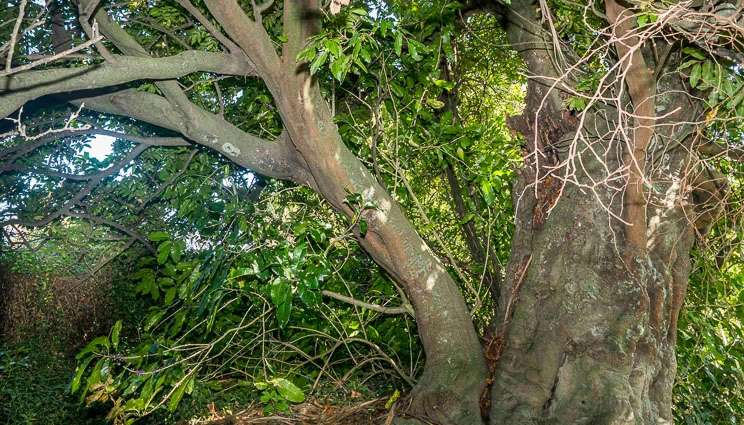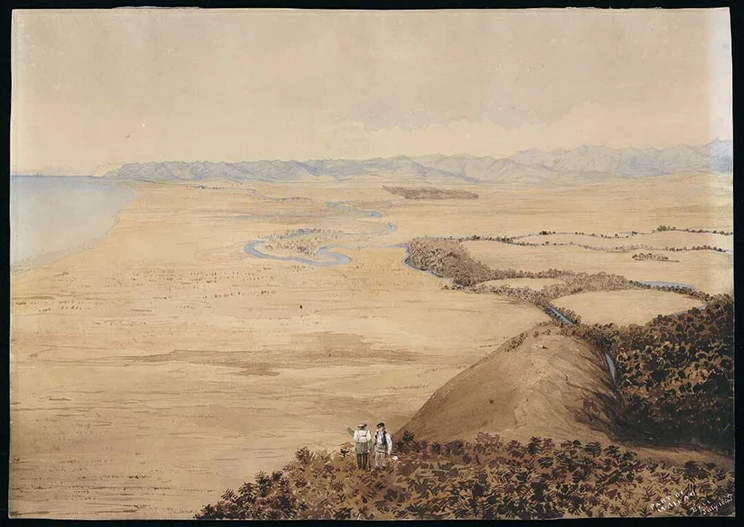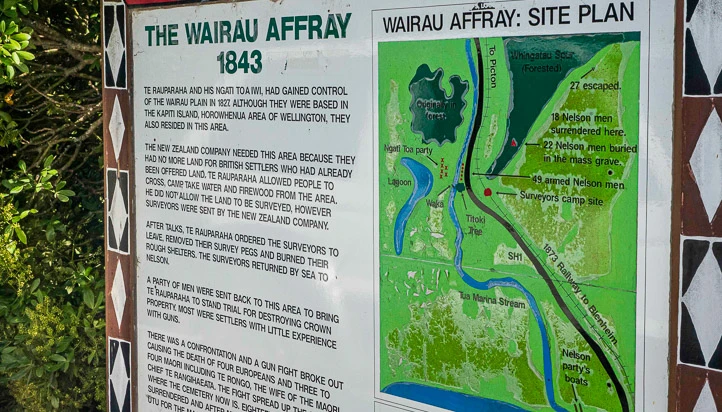The Wairau Affray: A series of unfortunate events
The 17 June 1843 Wairau Affray was the first major conflict between Māori and Pākehā after the signing of Te Tiriti o Waitangi only three years before. It was also the first of many conflicts that were part of Ngā Pakanga o Aotearoa | The New Zealand Wars.
‘Have I stolen a single nail?’
Have I stolen a single nail, that you should come and imprison me? Have I injured a European, or touched anything in his tent, although pitched upon lands you are plundering me of? May I not do as I please with my own blanket? You, and your own people are the robbers, and not me; go and manacle them, I will not go with you.
— Te Rangihaeata (Ngāti Toa) responding to his attempted arrest at Wairau

Image credit: The titoki tree the Pākehā posse used to cross the Tuamarina stream to confront Te Rauparaha, 2019 by Dylan Owen. All rights reserved.
The setting
Just kilometres north of Blenheim on State Highway 1 lies the unassuming side road, Pioneer Place, with a rest stop and small stone memorial partly obscured by trees. Across from the memorial, a small track drops down to a gnarled titoki tree overlooking the Tuamarina stream.
On 17 June 1843, a posse of armed Pākehā tied a waka to this tree to enable them to safely cross the stream. Their mission was to confront Te Rauparaha and Te Rangihaeata (both prominent Ngāti Toa rangatira) and arrest them for the arson of a surveyor’s hut in the Wairau Valley.
The Pākehā party comprised 47 men hastily recruited in Whakatū (Nelson). Although they were designated Special Constables, few had military or even policing experience. They were led by Chief Constable and magistrate, Henry Thompson, and Arthur Wakefield.
At the centre was land …
Wakefield was the New Zealand Company’s agent for Whakatū and brother to Edward Gibbon Wakefield, the founder of the New Zealand Company. This company commercially organised British settlement of Te Whanganui-a-Tara (Wellington), Whakatū and Whanganui in the 1840s.
The New Zealand Company’s initial settlement of Whakatū quickly ran up against a lack of available land for farming. One solution lay in expanding settlement into Marlborough’s Wairau Valley. However, that land didn’t belong to the New Zealand Company. Ngāti Toa (as mana whenua) and two of their rangatira, Te Rauparaha and Te Rangihaeata, were adamant it had not been sold nor would it be.
Nevertheless, an opportunistic New Zealand Company began an initial survey of the Wairau. In response, Te Rauparaha had the surveyors firmly, but courteously, escorted from the land.
Te Rauparaha had their [surveyors'] gear shifted from the huts and the toi-toi strips removed from the survey pegs. A bonfire was then made of the huts and toi-toi strips, Te Rauparaha maintaining that they were the property of the Maoris. Displaying no signs of animosity, Te Rauparaha helped the men carry their belongings to a canoe and shipped them to a pa at the mouth of the river. The surveyors were informed that the sooner they returned to Nelson the better it would be for them.
— Massacre recalled: The Wairau affair, ‘The Evening Post’, 21 February 1935

Image credit: Part of Wairau. Bell. July 1845 by Francis Bell. Ref: B-198-008 Alexander Turnbull Library.
A warrant was issued
When the surveyors returned to Whakatū | Nelson, Thompson initiated a court case that predictably resulted in a warrant being issued for the arrest of Te Rauparaha and Te Rangihaeata. Local volunteers were recruited or press-ganged, sworn in as Special Constables and, together with Thompson and Wakefield, the party set off by ship for the Wairau.
Thompson was a man with a known temper and no knowledge or interest in tikanga Māori (correct protocols). That was ironic. When appointed Police Magistrate, Thompson also assumed the then official role of (Nelson’s) Sub-Protector of Aborigines and Native Tenth Reserves trustee (though no gazetted notice for this role has been discovered, yet). In 1842, he had bullied his way to a resolution via a show of force against local Māori protesting over Pākehā coal mining at Motupipi. Perhaps he thought he could do it again when confronting Ngāti Toa.
But Thompson was facing down dozens of experienced toa (warriors), including two of the most formidable rangatira of the era.
The affray
However, on June 17 1843, when the two parties met on each side of the Tuamarina stream, all Te Rauparaha wanted was peace.
‘Kapai the korero, no good the fight,’ one Pākehā survivor recalled him saying.
Te Rauparaha continued, ‘Let us settle it quietly, and equitably, but do not fight, what if it does detain us two or three days.’
But Thompson wasn’t listening and insisted on arresting the chief, even attempting to handcuff him, an extraordinary insult to a man with so much mana (prestige). When Te Rauparaha refused, Thompson threatened that his party would open fire.
Both parties raised their guns …
Who fired the first shot? Perhaps, as some accounts suggest, a gun was accidentally discharged by one of the Pākehā crossing the stream using the waka. Te Rauparaha certainly thought Pākehā fired first:
There would have been no killing, but while we were arguing about boundaries, the Pakeha stood in file opposite us with their guns at their shoulders. Suddenly in the midst of our talk one of their guns exploded and the first wife of Te Rangihaeta, my nephew, stooping to arrange the stones of her hangi was shot through the breast. This unprovoked deed so enraged me that I cried: ‘Patua! Kia ngaro me to puehu pina aua e te liau!’ Kill them that they disappear as the dust that is known by the wind. Else all had ended in talk.
— Captain Wakefield at Wairau, ‘The Nelson Evening Mail’, 27 May 1933
Within minutes, Māori and Pākehā lay dead and the remainder of the posse fled up the Tuamarina hill, Ngāti Toa warriors in pursuit. At the top, Wakefield and his group surrendered. Others escaped down a spur and, with great difficulty, made their way back to Port Underwood and Whakatū | Nelson where they raised the alarm.
Unfortunately for the Pākehā who surrendered, Te Rangihaeata's wife Rongo (she was also Te Rauparaha’s daughter) was killed in the affray. Te Rangihaeata demanded utu (recompense) for this and other wrongs, and those who surrendered were killed by the rangatira.

Image credit: Wairau April 1851 by Charles Gold. Ref: A-329-014 Alexander Turnbull Library.
The aftermath
In all, four Māori died while 22 Pākehā were killed, including Thompson and Wakefield.
In the immediate aftermath, a Pākehā search party arrived and the Pākehā bodies were buried on the hill. Fearing Pākehā retribution, Marlborough Ngāti Toa left the region for the safety of the North Island.
Back in Whakatū | Nelson, settlers also feared imminent attack. A Public Safety Committee was established and Nelson’s Church Hill was fortified and renamed Fort Arthur. As well, Te Ara notes that ‘Māori were barred from attending church services for fear they would spy on the defences’.
There were also loud calls for immediate retaliatory action against Te Rauparaha and Te Rangihaeata.
The Protector of Aborigines, George Clarke, also addressed Māori through The New Zealand Gazette newspaper. Clarke's proclamation (originally printed in Māori) in part read:
The brig Victoria has arrived from Port Nicholson. The horizon is dark, the day exceedingly dark. News from above has reached us, stating that a conflict has taken place between the natives and Europeans. Some have fallen on both sides. With us both parties are wrong, according to the laws both of God and man … the Governor has sent down some troops to prevent the necessity of either Europeans or natives carrying arms — they are alike for the protection of natives as well as Europeans.
— Government proclamations respecting lands. Government circular to counteract their effect, ‘The Nelson Examiner and New Zealand Chronicle’, December 1843
An inquiry
In December of that year, Governor FitzRoy arrived in New Zealand. The following year, in February, he held an inquiry into the Wairau Affray at Waikanae. After formal greetings, FitzRoy addressed the hui:
I have heard of all that has happened at the Wairau from the Europeans. It has grieved my heart exceedingly. I now ask you to tell me your story that I may compare the two and judge fairly.
Te Rauparaha then replied:
We never agreed to that sale, and we never received any payment … The Wairau was taken away by Thompson and Captain Wakefield. When we heard they were surveying the land we went to Nelson to forbid their doing so. Captain Wakefield then said, ‘If you stop the surveying we will shoot you.’ … Mr Thompson said to me, ‘Rauparaha, spare my life.’ I answered, ‘A while ago I wished to talk with you in a friendly manner, and you would not; now you say save me. I will not save you; it is not our custom in war to save the chiefs of our enemies. We do not consider our victory complete unless we kill the chiefs of our opponents’.
After deliberating, FizRoy then replied, exonerating Te Rauparaha and Te Rangihaeata:
The Englishmen were very greatly to blame, and as they brought on and began the fight, and as you were hurried into crime by their misconduct, I will not avenge their death. In future let us dwell peaceably without at distrust. I have told you my decision, and my word is sacred.
In part, at the centre of this disastrous affray, lay an overpromise of land to European settlers, an ignorance of tikanga Māori, Treaty breaches and a British sense of racial superiority. Wakefield's body was found with damper (unleavened bread) placed under his head, a deliberate reference to his quote that he could buy off Māori with ‘sugar and bread’.
In hindsight, these attitudes and actions signposted what was to come but on a much larger, and for Māori, devastating scale.
Today, the Tuamarina site of the Wairau Affray, off Pioneer Place, is also marked by an information board.
The word ‘Tuamarina’ is itself a corruption of ‘Taumarino’, meaning ‘the calm beyond’.
To seek the calm beyond, to know where we are going, we need first to know what happened and why.

Image credit: A photograph of the information board designed by Tua Marina school pupils, 2019 by Dylan Owen. All rights reserved.
Aotearoa New Zealand histories
The information board was researched and designed by senior students at the local Tua Marina school, which itself was originally built to commemorate the affray.
This signifies a positive and meaningful way to engage with our histories. Aotearoa New Zealand histories content within te ao tangata | social sciences curriculum places emphasis on exploring and understanding histories and places at a local level as well as national.
The Wairau Affray offers a fascinating example of how local history can reveal the changing perspectives over the years. You only need to look at the event’s descriptors to begin to understand shifting attitudes. Initially labelled in the press as the ‘Wairau Massacre’, it has subsequently been called the ‘Wairau Incident’ and today is commonly referred to as the ‘Wairau Affray’.
It also offers a lesson around who remembers (and who overlooks) difficult events in our colonial past. Although it took place over 150 years ago, there are still diverse perspectives of this event and its aftermath, both within Pākehā New Zealand and various iwi.
Integrating local history and its consequences into teaching and learning, while acknowledging its many narratives, can help ākonga (students) build empathy and understanding around the ways our histories shape the present day.
Understanding primary sources … and a mystery
In writing this blog post, I used some newspaper reports from the time, especially those that gave a voice to the concerns and actions of Te Rauparaha and Te Rangihaeata over the Wairau.
Papers Past (digitised New Zealand and Pacific newspapers from the 19th and 20th centuries) represents an amazing opportunity to read first-hand accounts of 19th century New Zealand, including the kauhanga riri (campaigns) of Ngā Pakanga o Aotearoa (New Zealand Wars).
Of course, even these primary sources need to be treated with caution …
Primary source materials provide a range of voices that help history come alive. But each source is created in a specific cultural, historical, and personal context. They will reflect the attitudes, biases and values of the time, some of which are unacceptable today.
For example, the Wairau Affray was referred to as a ‘massacre’ in The Nelson Examiner and The New Zealand Gazette. Both of these newspapers were platforms for the New Zealand Company and were unabashedly pro-European-settler.
However, in one extraordinary letter to The Daily Southern Cross newspaper (September 11, 1843), the Wairau events were placed in a Māori context and the actions of both chiefs vigorously defended:
… I believe that interested parties have concealed from the public, the real character of the Wairau affray, and as I cannot perceive that either the Government authorities or the native Protectors have published anything satisfactory to the public … It is to be deeply regretted that the New Zealand Company have, from their first arrival in this country, been at variance with the natives, relative to lands. Large tracts of country have been sold to respectable parties in England, who have come out to New Zealand to occupy them, and on their arrival, they find the lands they have bought, have never been alienated by the natives …
— Original correspondence, ‘The Daily Southern Cross’, 16 September 1843
It is signed by ‘A Lover of Truth’, and the editor also notes:
We insert the above letter, but we do not vouch for its accuracy. We do not know the writer. We omit the last part because we cannot believe it to be true.
So, a mystery …
Who wrote the letter?
And just what was in ‘the last part’?
Learn more about Ngā Pakanga o Aotearoa | The New Zealand Wars
To find out more about the Wairau Affray and subsequent campaigns, Services to Schools has Ngā Pakanga o Aotearoa | The New Zealand Wars where you can discover quality learning resources covering this period of conflict.
This blog post
This post was originally published on 16 June 2020. It has been updated and republished in June 2021, 2022 and 2024.
Dear June, I have not heard your narrative before. Te Rongo and 3 Maori were buried on the Eastern side of the Tua Marina stream. Their bodies were found in 1938, and reinterred at Maori Island Urapa. The bodies were examined by Dr Redman, Te Rongo's only wound was a bullet going through her temple, so not in the back as you have been advised. A photo is available online using PapersPast. No one was shot at the Wairau river mouth, all those killed were buried at Tua Marina. There are some other graves along the hills, said to be those Maori who died of wounds heading towards Rarangi. I do not wish to publish where this grave is online as it is on private property now.